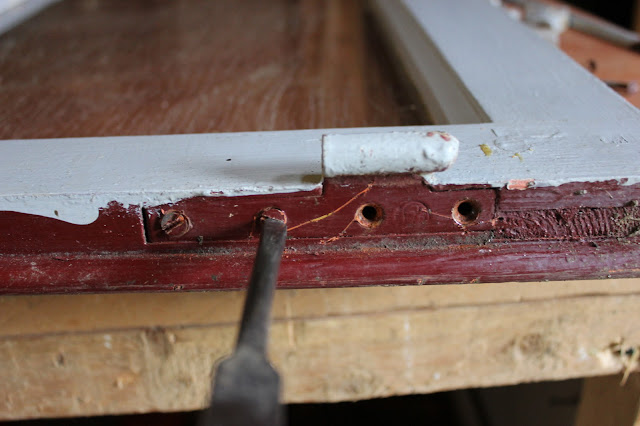The roof can be the crowning glory of the greenhouse and for this reason we decided to include a piece of leaded light in the design. England's old industrial heartlands of the Midlands and North are ever in a state of flux, a constant cycle of demolition and rebuild. You can if you are lucky still pick up some great examples of glass work, we have used many pieces in the house and in previous houses and gardens. My sister-in-law once obtained a few hours reprieve on an old Northern tram station, huge panels of leaded lights and thick pine panelling before the breakers got to it. If you see someone about to demolish aka smash up some great building and its materials, it's always worth just asking.
The Roof
 The polythene used for the roof was attached to seven equispaced roof trusses. The span of each truss was 3.3 metres so that there was an overhang of 15cm (6") on each side. The pitch of the roof was 25 degrees.
The polythene used for the roof was attached to seven equispaced roof trusses. The span of each truss was 3.3 metres so that there was an overhang of 15cm (6") on each side. The pitch of the roof was 25 degrees. Each leg of the truss was 1.8m in length and at the time I built this I hadn't sufficient recuperated timber to make all of the trusses of solid timber so I decided to make the gables and centre trusses from 100mm x 40mm (4" x 1.5") timber and the other four trusses from a 'sandwich' of shorter lengths of 100mm x 25mm (4" x 1") planks, screwed and nailed together at the overlap.
Each leg of the truss was 1.8m in length and at the time I built this I hadn't sufficient recuperated timber to make all of the trusses of solid timber so I decided to make the gables and centre trusses from 100mm x 40mm (4" x 1.5") timber and the other four trusses from a 'sandwich' of shorter lengths of 100mm x 25mm (4" x 1") planks, screwed and nailed together at the overlap.
As all of these trusses had to have the same angle, I made a jig to ensure that this could be easily attained. I used the exact same method when I built the 5 Euro greenhouse (photos above). Here is the link to that project.
The gable-end trusses and the central truss were bolted to the 3" square wooden posts, the other 4 trusses were screwed to the top-edge of the windows. The trusses were joined to each other with pallet planks screwed to the underside face of the truss. These planks acting as purlins stiffened the whole roof structure.
IMPORTANT NOTE In the subsequent two greenhouses I've built, the trusses were connected with pallet planks at the apex of the structure. I've found that this ridge purlin arrangement looks more aesthetic than that in the glass greenhouse. Also, for the glass greenhouse roof I rounded off the apex of each truss so as not to pierce the roof covering in severe loading conditions.
Using the ridge purlin arrangement the whole roof cover would be much better supported. Nevertheless, even in heavy snow conditions the roof material has never been compromised.
One other important feature of this construction is that the two steel-staked posts that were half way along the greenhouse were driven in place after the pallet walls were assembled. This was because I thought it was too difficult to obtain an exact matching point as the windows within each wall were of differing widths. I found that it was much easier to put the post in once the walls and windows were up. I chose the nearest window to the midpoint aligning the post to the window's stile (vertical part of the frame). A thick piece of timber (approx. 50mm 2" and pictured above far right) filled the gap between the post and the stile. I knew that the posts would not be directly in line with each other but decided that the central roof truss could be attached to the opposite faces of the posts to compensate for this.
Covering the roof
The roofing material of 200micron UV-stabilised polyethylene, was held in place with wooden laths screwed through it into the truss and window timber. Initially I was concerned about piercing the material fearing at best a leaking roof and at worst a point of propagation for tears. Neither has happened despite several Winter's worth of gale force winds, although in fairness we have grown shelter belt hedges in the garden to reduce the effect of the wind.
Rainwater recovery from the roof is via gutters along each side of the greenhouse emptying into barrels. We have also found it beneficial for the barrels to be inclined slightly such that in the event of their overflowing the water runs towards the greenhouse.
If you have enjoyed this article and found it interesting then share it with your friends on social media or suchlike. Please also feel free to ask questions and or make comments and if you found this helpful and would like to support this site you can always
Cheers, Andy
© Andy Colley 2014
RELATED ARTICLES
 The 5 Euro/Dollar/Pound Greenhouse
The 5 Euro/Dollar/Pound Greenhouse
Home-made low cost greenhouse designed to use free untreated pallet
wood. How to build a viable, safe, year-round food production system...read more
 Home-made, Big Cheap Glass Greenhouse from Old Windows Pt 1 - Design
Home-made, Big Cheap Glass Greenhouse from Old Windows Pt 1 - Design
The idea for the greenhouse was to have something that was both decorative and practical...read more
 Home-made, Big Cheap Glass Greenhouse from Old Windows Pt 2 - Construction
Home-made, Big Cheap Glass Greenhouse from Old Windows Pt 2 - Construction
Although it is a large sized greenhouse and in itself quite an imposing
feature, it actually fits very well into its surrounding landscape...read more











































